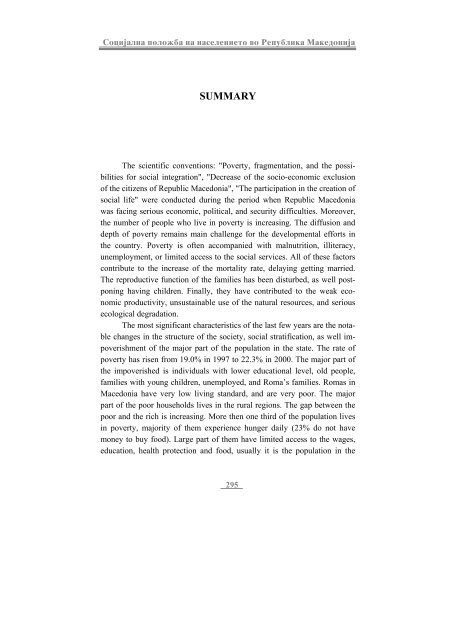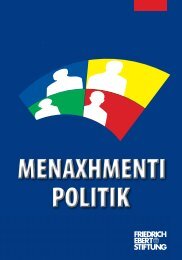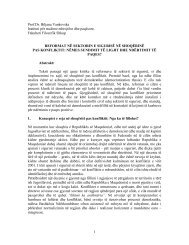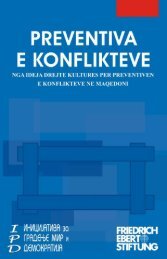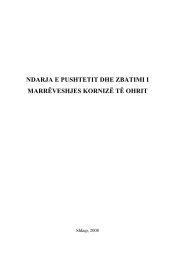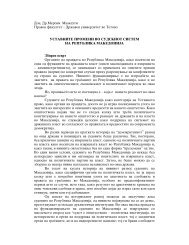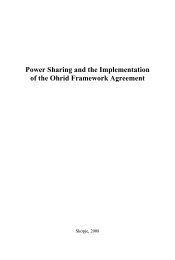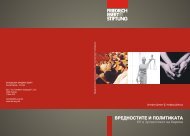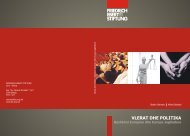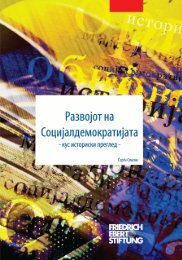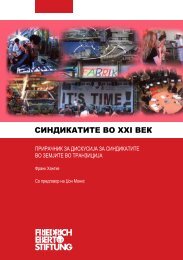- Page 1 and 2:
Institut za sociolo{ki ipoliti~ko-p
- Page 3 and 4:
Socijalna polo`ba na naselenieto vo
- Page 6 and 7:
Sodr`inaDISKUSII:Mirjana Borota -Po
- Page 8 and 9:
Jorde Jakimovski; Predgovornite pro
- Page 10 and 11:
Jorde Jakimovski: Rezimetija, od ko
- Page 12 and 13:
Jorde Jakimovski: RezimeRepublika M
- Page 14 and 15:
Jorde Jakimovski: RezimeVo ovoj per
- Page 16 and 17:
Jorde Jakimovski: Preporakivr{eweto
- Page 19:
I. NAU^EN SOBIR:SIROMA[TIJATA,FRAME
- Page 22 and 23:
Jorde Jakimovski: Siroma{tijata i f
- Page 24 and 25:
Jorde Jakimovski: Siroma{tijata i f
- Page 26 and 27:
Jorde Jakimovski: Siroma{tijata i f
- Page 28 and 29:
Jorde Jakimovski: Siroma{tijata i f
- Page 30 and 31:
Jorde Jakimovski: Siroma{tijata i f
- Page 32 and 33:
Ilija Todorovski:Niskiot op{testven
- Page 34 and 35:
Ilija Todorovski:Niskiot op{testven
- Page 36 and 37:
Ilija Todorovski:Niskiot op{testven
- Page 38 and 39:
Ilija Todorovski:Niskiot op{testven
- Page 40 and 41:
Ilija Todorovski:Niskiot op{testven
- Page 42 and 43:
Ilija Todorovski:Niskiot op{testven
- Page 44 and 45:
Qubica ^oneva:Socijalno-ekonomskata
- Page 46 and 47:
Qubica ^oneva:Socijalno-ekonomskata
- Page 48 and 49:
Qubica ^oneva:Socijalno-ekonomskata
- Page 50 and 51:
Qubica ^oneva:Socijalno-ekonomskata
- Page 52 and 53:
Qubica ^oneva:Socijalno-ekonomskata
- Page 54 and 55:
Vesna R. Dimitrievska: Karakteristi
- Page 56 and 57:
Vesna R. Dimitrievska: Karakteristi
- Page 58 and 59:
Vesna R. Dimitrievska: Karakteristi
- Page 60 and 61:
Vesna R. Dimitrievska: Karakteristi
- Page 62 and 63:
Vesna R. Dimitrievska: Karakteristi
- Page 64 and 65:
Vesna R. Dimitrievska: Karakteristi
- Page 66 and 67:
Ru`ica Cacanovska: Verskite zaednic
- Page 68 and 69:
Ru`ica Cacanovska: Verskite zaednic
- Page 70 and 71:
Ru`ica Cacanovska: Verskite zaednic
- Page 72 and 73:
Ru`ica Cacanovska: Verskite zaednic
- Page 74 and 75:
Ru`ica Cacanovska: Verskite zaednic
- Page 76 and 77:
Slavejko Sasajkovski: Nova levicaol
- Page 78 and 79:
Slavejko Sasajkovski: Nova levicaov
- Page 80 and 81:
Slavejko Sasajkovski: Nova levicaVo
- Page 82 and 83:
Slavejko Sasajkovski: Nova levicaVo
- Page 84 and 85:
Slavejko Sasajkovski: Nova levicaPr
- Page 86 and 87:
Slavejko Sasajkovski: Nova levicaja
- Page 88 and 89:
Slavejko Sasajkovski: Nova levicaku
- Page 90 and 91:
Slavejko Sasajkovski: Nova levicaNe
- Page 92 and 93:
Mirjana S .- Dineva Javnite slu`bi
- Page 94 and 95:
Mirjana S .- Dineva Javnite slu`bi
- Page 96 and 97:
Mirjana S .- Dineva Javnite slu`bi
- Page 98 and 99:
Mirjana S .- Dineva Javnite slu`bi
- Page 100 and 101:
Mirjana S .- Dineva Javnite slu`bi
- Page 102 and 103:
Mirjana S .- Dineva Javnite slu`bi
- Page 104 and 105:
Blagoja Nanevski: Ekonomskiot razvo
- Page 106 and 107:
Blagoja Nanevski: Ekonomskiot razvo
- Page 108 and 109:
Blagoja Nanevski: Ekonomskiot razvo
- Page 110 and 111:
Blagoja Nanevski: Ekonomskiot razvo
- Page 112 and 113:
Blagoja Nanevski: Ekonomskiot razvo
- Page 114 and 115:
DISKUSII116
- Page 116 and 117:
Dimitrija Trajkovski: Mladite i sir
- Page 118 and 119:
Dimitrija Trajkovski: Mladite i sir
- Page 120 and 121:
Lazar Lazarov: Zaminuvawe bez vra}a
- Page 122 and 123:
Lazar Lazarov: Zaminuvawe bez vra}a
- Page 124 and 125:
Lazar Lazarov: Zaminuvawe bez vra}a
- Page 126 and 127:
Lazar Lazarov: Zaminuvawe bez vra}a
- Page 128 and 129:
Lazar Lazarov: Zaminuvawe bez vra}a
- Page 130 and 131:
Kosta Milkov: Siroma{tijata i Evang
- Page 132 and 133:
Kosta Milkov: Siroma{tijata i Evang
- Page 134 and 135:
Kosta Milkov: Siroma{tijata i Evang
- Page 136 and 137:
Olivera Petrova - Kov~egarska: Fakt
- Page 138 and 139:
Olivera Petrova - Kov~egarska: Fakt
- Page 140 and 141:
Olivera Petrova - Kov~egarska: Fakt
- Page 142 and 143:
Olivera Petrova - Kov~egarska: Fakt
- Page 144 and 145:
Olivera Petrova - Kov~egarska: Fakt
- Page 146 and 147:
Zoran Vu~ev: Siroma{tijata gledana
- Page 148 and 149:
Zoran Vu~ev: Siroma{tijata gledana
- Page 150 and 151:
Zoran Vu~ev: Siroma{tijata gledana
- Page 152 and 153:
Zoran Vu~ev: Siroma{tijata gledana
- Page 154 and 155:
Zoran Vu~ev: Siroma{tijata gledana
- Page 156 and 157:
Aleksandar Petroski: Investiciite k
- Page 158 and 159:
Aleksandar Petroski: Investiciite k
- Page 160 and 161:
Aleksandar Petroski: Investiciite k
- Page 162 and 163:
Aleksandar Petroski: Investiciite k
- Page 164 and 165:
Aleksandar Petroski: Investiciite k
- Page 166 and 167:
Jorde Jakimovski:Zadovoluvawe na os
- Page 168 and 169:
Jorde Jakimovski:Zadovoluvawe na os
- Page 170 and 171:
Jorde Jakimovski:Zadovoluvawe na os
- Page 172 and 173:
Jorde Jakimovski:Zadovoluvawe na os
- Page 174 and 175:
Jorde Jakimovski:Zadovoluvawe na os
- Page 176 and 177:
Jorde Jakimovski:Zadovoluvawe na os
- Page 178 and 179:
Qubica ^oneva: Ekskluzijata i socij
- Page 180 and 181:
Qubica ^oneva: Ekskluzijata i socij
- Page 182 and 183:
Qubica ^oneva: Ekskluzijata i socij
- Page 184 and 185:
Qubica ^oneva: Ekskluzijata i socij
- Page 186 and 187:
Qubica ^oneva: Ekskluzijata i socij
- Page 188 and 189:
Katerina No{paloska, Stojan Trajano
- Page 190 and 191:
Katerina No{paloska, Stojan Trajano
- Page 192 and 193:
Katerina No{paloska, Stojan Trajano
- Page 194 and 195:
Katerina No{paloska, Stojan Trajano
- Page 196 and 197:
Ilija Todorovski: Mo`nostite na soc
- Page 198 and 199:
Ilija Todorovski: Mo`nostite na soc
- Page 200 and 201:
Ilija Todorovski: Mo`nostite na soc
- Page 202 and 203:
Ilija Todorovski: Mo`nostite na soc
- Page 204 and 205:
Ilija Todorovski: Mo`nostite na soc
- Page 206 and 207:
Ilija Todorovski: Mo`nostite na soc
- Page 208 and 209:
Ilija Todorovski: Mo`nostite na soc
- Page 210 and 211:
Ilija Todorovski: Mo`nostite na soc
- Page 212 and 213:
Maria Donevska: Socijalno isklu~uva
- Page 214 and 215:
Maria Donevska: Socijalno isklu~uva
- Page 216 and 217:
Zoran Vu~ev: Ekskluzijata gledana o
- Page 218 and 219:
Zoran Vu~ev: Ekskluzijata gledana o
- Page 220 and 221:
Zoran Vu~ev: Ekskluzijata gledana o
- Page 222 and 223:
Zoran Vu~ev: Ekskluzijata gledana o
- Page 224 and 225:
Olivera Petrova Kov~egarska: Socija
- Page 226 and 227:
Olivera Petrova Kov~egarska: Socija
- Page 228 and 229:
Olivera Petrova Kov~egarska: Socija
- Page 230 and 231:
232
- Page 232 and 233:
Jorde Jakimovski:Participacijata ka
- Page 234 and 235:
Jorde Jakimovski:Participacijata ka
- Page 236 and 237:
Jorde Jakimovski:Participacijata ka
- Page 238 and 239:
Jorde Jakimovski:Participacijata ka
- Page 240 and 241:
Jorde Jakimovski:Participacijata ka
- Page 242 and 243: Stojan Trajanov, Katerina No{palosk
- Page 244 and 245: Stojan Trajanov, Katerina No{palosk
- Page 246 and 247: Stojan Trajanov, Katerina No{palosk
- Page 248 and 249: Stojan Trajanov, Katerina No{palosk
- Page 250 and 251: Stojan Trajanov, Katerina No{palosk
- Page 252 and 253: Stojan Trajanov, Katerina No{palosk
- Page 254 and 255: Stojan~e Mitovski: Obrazovanieto ka
- Page 256 and 257: Stojan~e Mitovski: Obrazovanieto ka
- Page 258 and 259: Stojan~e Mitovski: Obrazovanieto ka
- Page 260 and 261: Stojan~e Mitovski: Obrazovanieto ka
- Page 262 and 263: Stojan~e Mitovski: Obrazovanieto ka
- Page 264 and 265: Stojan~e Mitovski: Obrazovanieto ka
- Page 266 and 267: K. M. Powavi} - S. Lazovski: Dano~n
- Page 268 and 269: K. M. Powavi} - S. Lazovski: Dano~n
- Page 270 and 271: K. M. Powavi} - S. Lazovski: Dano~n
- Page 272 and 273: K. M. Powavi} - S. Lazovski: Dano~n
- Page 274 and 275: K. M. Powavi} - S. Lazovski: Dano~n
- Page 276 and 277: K. M. Powavi} - S. Lazovski: Dano~n
- Page 278 and 279: K. M. Powavi} - S. Lazovski: Dano~n
- Page 280 and 281: K. M. Powavi} - S. Lazovski: Dano~n
- Page 282 and 283: K. M. Powavi} - S. Lazovski: Dano~n
- Page 284 and 285: Mirjana Borota Popovska: Participac
- Page 286 and 287: Mirjana Borota Popovska: Participac
- Page 288 and 289: Ru`ica Cacanoska: Participacijata v
- Page 290 and 291: Jorde Jakimovski: RecommendationsRE
- Page 294 and 295: Jorde Jakimovski: Summarymountain a
- Page 296 and 297: Jorde Jakimovski: Summaryexploitati


